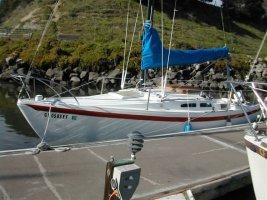I need to pick your collective brains about an apparent leak issue on my E27. I say "apparent" leak, because after successfully caulking my windows, I noticed water is seeping from the joint in the cabin between the deck and hull, directly inside the rub rail. During my window repair, I looked very closely and the inner/outer cabin shells are hollow in the vertical section around the windows. This let me to assume the water was from the windows.
It could be that water is seeping along this from somewhere and dripping out at the point where gravity makes it collect, where capillary action pulls it, or both. Therefore, I would not be surprised if the rub rail is letting water leak in, but I don't know enough about a hull design to know if there is even an indirect path from the rub rail to the inner joint.
Something that worries me is the teak hand rails on both sides are in bad enough shape to leak water into the cabin (this is where some the bolts are exposed to the cabin - apparently a bad repair from years ago when someone cut into the cabin roof to access the hand rail anchors). I mention this to suggest that maybe, if it is possible, the water is coming from the cabin-mounted hardware such as winches, cheek blocks, etc.
If cabin-mounted hardware is the fault, then perhaps the slow leak in the mast section is accumulating, then slowly seeping down to the joint? I know the mast *slowly* seeps water since the wood support swells after a good rain. So there's another suspect in the lineup.
After all this speculation, the most logical assumption I can think of is that years of leaking windows have caused water to seep into this area, which is slowly leaking back out. Would this be logical, or would that kind of trapped water have already leaked back out?
I'm sorry if these questions seem , but my grasp of hull design is rather challenged. My goal is to isolate if this water is bad (all water inside is bad, isn't it???) and possible solutions to identify the source.
TIA,
- Jerry
It could be that water is seeping along this from somewhere and dripping out at the point where gravity makes it collect, where capillary action pulls it, or both. Therefore, I would not be surprised if the rub rail is letting water leak in, but I don't know enough about a hull design to know if there is even an indirect path from the rub rail to the inner joint.
Something that worries me is the teak hand rails on both sides are in bad enough shape to leak water into the cabin (this is where some the bolts are exposed to the cabin - apparently a bad repair from years ago when someone cut into the cabin roof to access the hand rail anchors). I mention this to suggest that maybe, if it is possible, the water is coming from the cabin-mounted hardware such as winches, cheek blocks, etc.
If cabin-mounted hardware is the fault, then perhaps the slow leak in the mast section is accumulating, then slowly seeping down to the joint? I know the mast *slowly* seeps water since the wood support swells after a good rain. So there's another suspect in the lineup.
After all this speculation, the most logical assumption I can think of is that years of leaking windows have caused water to seep into this area, which is slowly leaking back out. Would this be logical, or would that kind of trapped water have already leaked back out?
I'm sorry if these questions seem , but my grasp of hull design is rather challenged. My goal is to isolate if this water is bad (all water inside is bad, isn't it???) and possible solutions to identify the source.
TIA,
- Jerry
Last edited:

